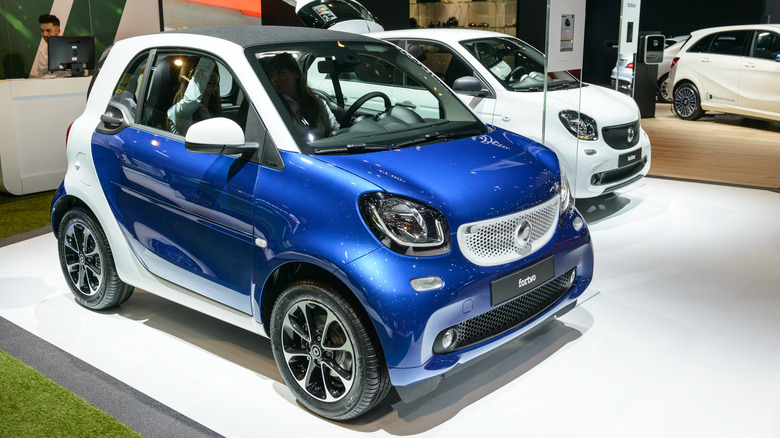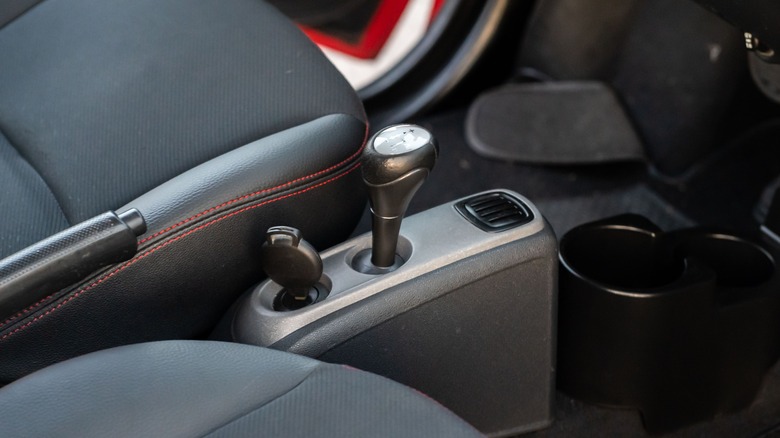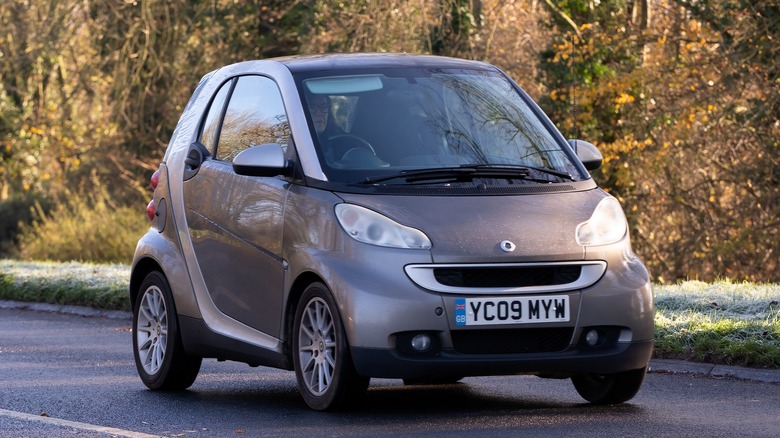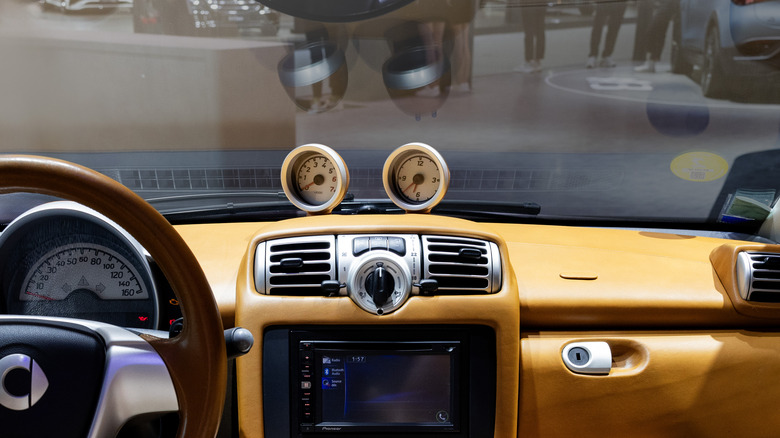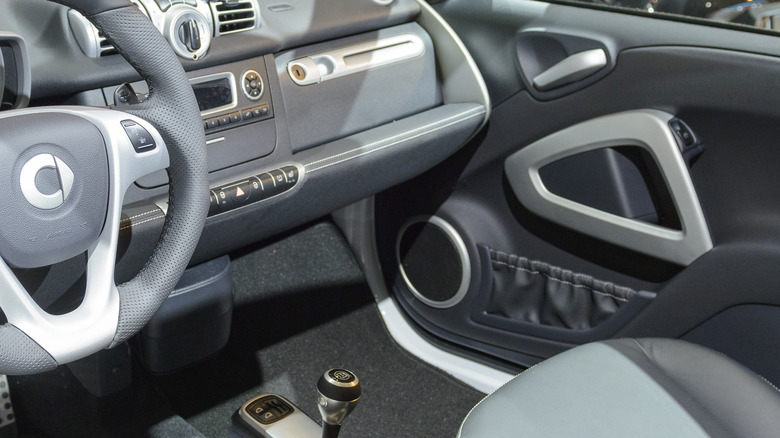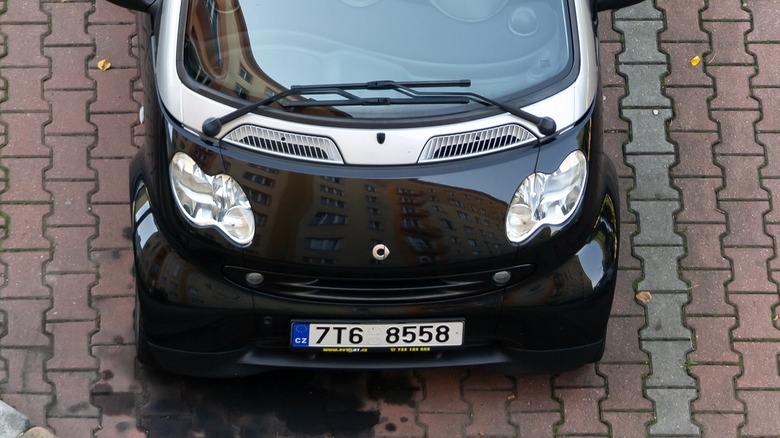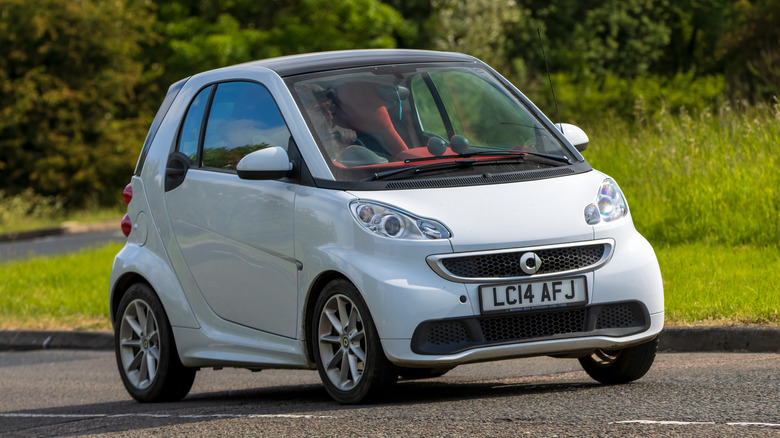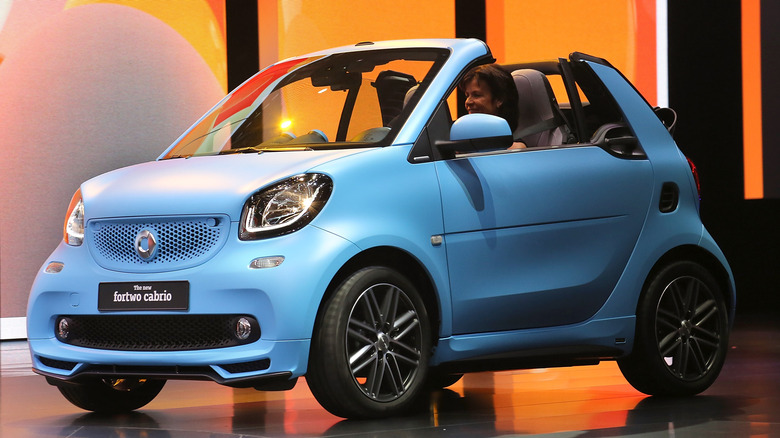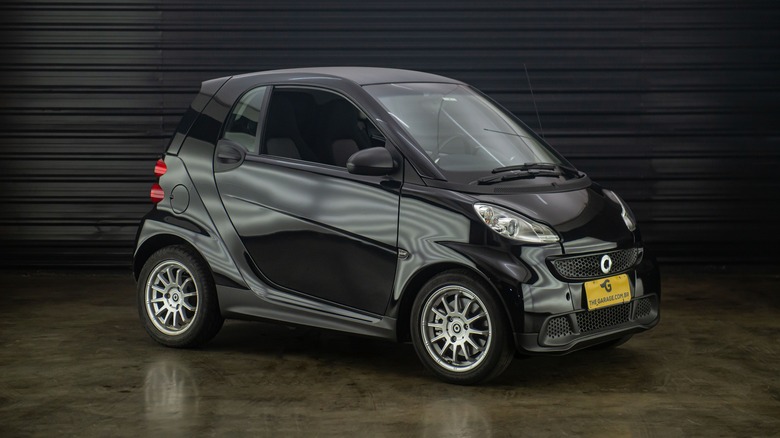8 Hidden Smart Car Features You Should Know As A Buyer Or Driver
The Smart Fortwo is at this point an internet hall-of-famer, in the same infamous league as stuff like the Toyota Prius and the Chrysler PT Cruiser, and it's there for the same reason: Everyone loves to make fun of it. It's small, it doesn't have all that much power, and it's not the most refined automobile in the world. An easy target, right? Not so fast.
Setting aside the jokes, which admittedly can be funny sometimes, the Smart Fortwo was a total revolution. When it launched in the late 90s, it was the perfect response to metropolitan areas all over the world getting increasingly crowded. It's absolutely tiny and can fit just about anywhere, and what's more, it can go farther on a tank of gas than you might think.
It was also a revolution in small car safety. The car featured a steel Tridion safety cell that wraps around the cabin, and the rest of the body panels were plastic for easy and cheap replacement. There's so much more to the Smart car than just that, however. Believe it or not, it hides some pretty neat features.
Transmission tricks
The first and second generation Smart Fortwo both came with a very similar transmission: a six-speed semi-automatic, also known as a robotized manual. While we can cut the second generation car a little slack, as it also introduced an improved five-speed semi-automatic, the six-speed transmission became known the world over for being super jerky and not very nice to use, and it has been mercilessly mocked, even by owners. But for as flawed as it was, it had a few tricks.
Firstly, giving it more gas when the time comes to change gear was not the right thing to do. Driving a semi-automatic car is slightly different than a conventional automatic. You have to be understanding and give the gearbox some space by backing off the throttle just before the gear change is about to occur. Because the engine is right behind you, you'll be able to hear it, as well as see it on the tachometer.
Another trick is when you, say, parallel park on a hill. The Smart car doesn't necessarily have a park gear, at least not the first-generation and the European spec second-generation models. To avoid accidental rolling down hills even if it's in neutral and the parking brake is on, leaving it in reverse and pulling the parking brake can actually prevent you from rolling down more effectively. With the key being placed right below the shifter, this all sounds very familiar. Of course, there's also the more well-known trick: Pressing the button on the shifter switches from automatic to manual shifting mode, and vice versa, instantly.
The engines are pretty robust
You're probably thinking this sounds insane. A really tiny three-cylinder engine and engineering from Mercedes in the 2000s? Believe it or not, the Smart Fortwo's powertrains can take a beating. However, it's worth noting that the second generation car's MHD (micro hybrid drive) mild hybrid is best avoided, unless you want to spend some dough on the auxiliary belt more frequently than you should.
The rest of the powertrain lineup is solid, however. The first generation's three-cylinder gas units and the two-cylinder diesels will run basically forever if well-maintained. The second generation scores extra brownie points in the reliability department, as its three-cylinder gasoline engines come directly from Mitsubishi, makers of the super underrated Montero.
Sure, this is a vehicle engineered by Mercedes-Benz in the 2000s, so there are a few minor asterisks we will get to. But, purely focusing on the engine options, as long as the maintenance has been kept in check, the Smart car shouldn't really give you any major issues.
The gauge pods are very easy to swap
Among the most notable and recognizable features of the Smart Fortwo are the gauge pods, mounted right in the center of the dashboard. These lean into the Mercedes and Swatch partnership that birthed the Smart car itself, and they consist of a clock and a tachometer. Some Smart cars didn't come with these from the factory, but most of them did.
Generally speaking, the tachometer goes on the left, and the clock goes on the right. If you have a RHD Smart, the order is obviously reversed. These pods can be tilted at any horizontal angle you want for better visibility, but there's also a way to swap their positions.
The plastic base that holds the two gauge pods on the dash is very easily removable, and that makes it easy to choose which one of the gauge pods you want to bring closer to you. Helpful if, say, you spend most of your time driving in automatic mode and you don't really need to see the tachometer all that frequently.
The battery is in the passenger footwell
If you're looking to buy a Smart car, or you just bought one, you've likely asked yourself at least once: where's the battery? Almost the entire rear of the car is occupied by the engine, and there's no real hood to speak of on the first generation and second generation models. The front panel also doesn't open.
Actually, the battery is located in the passenger footwell. Once you pull away the carpeting, there's a plastic cover on the floor, which is also the reason why the footwell on the passenger side is not quite as spacious. Once you remove the plastic, you can access the battery, and this is also where you can connect jumper cables. No separate jump points here, even though it's technically a Mercedes.
Speaking of, if the time comes to replace the battery in your Smart car, the gasoline powered second-gen Fortwo (451) takes group size 47. If you have the MHD, make sure you're looking at an AGM battery, as it goes the best with the stop-start system. Also, be sure to choose the right brand of car battery.
Hidden compartments above the hood
Once again, if you haven't had experience with the Smart car previously, some things might bother you. Since there's no real hood in the front and it would be awkward to top up washer fluid in the back, where does it actually go?
This only applies to the first-generation 450 Fortwo, but it's still a great idea. On the front, nestled inside the Tridion safety cell, there are two vents that seem to be there for style purposes only. However, if you insert the ignition key into the plastic cap and twist it, you can remove the plastic vent cover revealing the cap to the washer fluid reservoir. Once you're done, re-install the plastic cover and screw it back in using the ignition key.
The more common 451 Fortwo actually has an opening panel in the front, though it has a backward hinge. There are two latches in either corner of the front "grille" that you have to undo, and then you can top up the fluid there. In the third-generation Fortwo, there was simply a hood — not quite as interesting, but definitely something we're all more used to. Speaking of washer fluid, there is actually a way to make your own at home.
The ECU in the first-gen car is a ticking timebomb
It's time to address the elephant in the room. Mercedes-Benz vehicles from the early-mid 2000s are known for their electrical gremlins, and sadly, the Smart car was unable to escape that curse. Even though it has way less electronics and fewer complicated components than, for example, a W220 S-Class, the ECU is definitely a ticking timebomb.
Signs of ECU failure and overdue replacement include... stalling. You'll be on the move at a decent speed, and all of a sudden the engine cuts out and the gear indicator on the dash displays the all-conquering evil of the Smart Fortwo: the three lines. This is one of the most documented issues about the Smart Fortwo — one I myself have experienced — and it was still a concern even on the 451 cars. Thankfully, the third-generation cars seem to have ironed it out.
Weird car connoisseur Robert Dunn of the Aging Wheels YouTube channel was also blessed with ECU failure on his first gen Smart car, and after attempting to fix it, the ECU revealed that the odometer had been tampered with. If the ECU ends up going in your Smart car, don't bother, just replace it. Get ready to budget a fair bit of cash, also.
Third gens are the most refined
We haven't really given any love to the third-generation Smart car, which was sold very briefly in North America. Despite all the right intentions, North America simply had fallen out of love with the tiny car. In fact, Americans were never really in love with it to begin with, as evident in the constant mocking of the NYPD's own Fortwo patrol car.
In our review of the third-generation Fortwo, we thought the tiny car had a lot going for it. For starters, humble Renault underpinnings made it far simpler and cheaper for maintenance and repairs. It was also the most refined of the three generations, being surprisingly competent at highway cruising. What's more, it offered the most powerful engines in the model's history, again adding further to its highway capability.
While this next one is not very important, it can mean for a lot of buyers. The third generation Smart is also the most "conventional" of the three, meaning you don't have to re-train everything you know about driving a car to get used to it. There's an actual hood in the front, and the ignition tumbler is in the normal place, by the steering column. There's no learning curve to the transmission either, as due to the endless complaints, Smart switched from a semi-automatic transmission to a much faster dual-clutch unit in the third gens. For the first time, there was also a proper three-pedal manual.
Used Smart Cars won't cost you a lot of money
So, how much will this tiny curiosity actually cost you to buy? Well, there's all manner of Smart cars on the used market, and prices go from less than $10,000 to around $15,000. As mentioned previously, it's a good idea to stay away from the MHD mild hybrid, as they have some pretty notable reliability issues.
Also, tempting though they may be, you should also avoid the EQ electric model. While they cost the same sort of money, they're getting on a little and the batteries have certainly started to degrade. Not that the range was very good to begin with. Stick with the gasoline and diesel powered models.
Stick to the Passion trim level, as that one includes luxuries like alloy wheels, cruise control, fully body colored panels and, if you're lucky, heated seats. 451 Smart cars (second gens) huddle around $8,000, and that's how much you should be paying. Just make sure there's a full service history and look out for any odd behaviors. The 451 wins hands down in terms of reliability and strikes the perfect balance of modern, but also Smart car levels of quirky. Anything in the neighborhood of $10,000 should get you a solid example.
